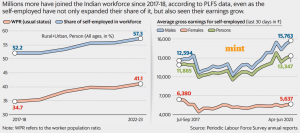ForumIAS announcing GS Foundation Program for UPSC CSE 2025-26 from 19 April. Click Here for more information.
Source: This post on India’s informal sector has been created based on the article “India’s informal sector could be adding more value than we know” published in “Live Mint” on 14th December 2023.
UPSC Syllabus Topic: GS Paper 3 Indian Economy – Issues relating to growth, development and employment.
News: The article discusses the procedure for calculating the contribution of the informal sector to the GDP. It cites the PLFS Data to argue that the contribution of the informal sector in the economy is not declining.
Some experts have highlighted that since a GDP base revision (updating the reference year used for calculating and comparing the country’s economic output) is long overdue, the recently released second-quarter GDP estimates are unreliable. It is argued that as they do not adequately capture the informal sector, the GDP estimates are also consequently over-estimated.
Why do experts think it is?
The argument being given for the above is that the country’s informal sector, after both demonetization and COVID, has seen a large decline in its ability to contribute to economic value addition.
But since GDP calculation estimates the contribution of the informal sector indirectly (by measurements drawn from the formal sector), the size and contribution of the sector is overstated.
What are the flaws in the argument?
- Informal Sector assessment not completely indirect: The assessment of the informal sector’s contribution to the GDP is not entirely indirect.
For instance, agriculture (which is almost 40% of informal sector GVA) is assessed through direct estimates of production. The construction sector, which is the second major component of this sector, is also assessed through the production of key inputs like cement, steel, etc. - Growth in value-added due to trade is inferred from data on tax collections.
Thus, these significant components of informal sector activity are calculated from data elements that are performing well.
What does the PLFS data reveal about the status of the informal sector?
Source: LiveMint.
Rise in Worker Population Ratio (WPR): Between 2017-18 and 2022-23, the Worker Population Ratio (WPR) for all ages (rural+urban) rose significantly from 34.7% to 41.1%. This rise, combined with the rise in India’s population over the same period implies a substantial increase in the number of informal enterprises. Thus, in size terms, the informal sector has not declined.
Rise in the Share of Self-Employed: It has also increased from 52.2% to 57.3%.
Rise in Gross Earnings: PLFS data also reveals that average gross earnings for self-employed people shows that the growth in earnings post July 2020 is almost 6.5% per year.
Initially we witness a stagnation in earnings as a consequence of GST implementation and COVID-lockdowns. Subsequently, there has been a revival which can be explained by the momentum gained in financial inclusion and credit outreach aimed at the informal sector.
Thus, there does not appear to be a case that the contribution of the informal sector has declined.
Question for practice:
What is the current status of the informal sector in India? What are the challenges ailing it?





